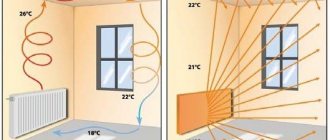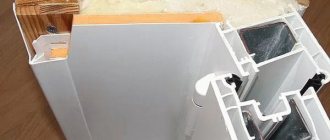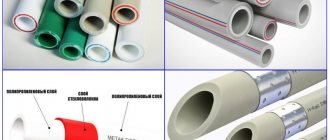Here you will learn:
- What heat waves are emitted by infrared panels
- The main advantages and disadvantages of infrared heating panels
- Cost-effectiveness of using infrared heating panels
- Fire safety
- The influence of IR radiation on humans
- What are the types of infrared heating panels?
- How to choose the right IR panel
- Installation features
Heating a room with infrared radiation is a revolutionary method that treats not so much the air itself as the objects in the room. The IR source acts on space like the Sun on our planet.
All other heating methods (batteries, oil heaters, etc.) work on the principle of convection heating of air masses. That is, cold (unheated) air flows around a hot surface and receives heat from it. An increase in temperature entails a decrease in density, as a result, according to the law of physics, air rushes upward.
But we don't live on the ceiling. It is important for us that the comfortable air temperature is in the central and lower third of the room.
There is nothing complicated about the design of IR panels - it’s surprising how humanity didn’t think about their invention earlier! The infrared heat emitted by heaters is similar in power and structure to solar rays
A device that heats not the air, but floors, furniture and even your skin, is an infrared panel. Only after heating of these surfaces is heat transferred to the surrounding air. Heating of the room begins from below, thereby ensuring a comfortable temperature in the area of human activity.
And now those people who are at least a little familiar with physics will have a logical question - why are the heat rays of IR panels not immediately absorbed by the air? This is the whole “trick” of these devices!
In the infrared region there are a kind of “black holes” where heat rays are weakly absorbed. The widest such “window” is located in the range of 8-13.5 microns. If thermal radiation has a wavelength close to it, the air throughput in this case is 80-85%, so IR rays reach the surface unhindered.
What heat waves are emitted by infrared panels
In the case of traditional heating, according to the principle of air circulation in the room, the heat increases. Therefore, the space under the ceiling heats up more than on the floor. In the case of infrared heating, walls, objects and people heated by the thermal infrared panels generated by the heat release the accumulated heat, thereby achieving thermal comfort throughout the room with an even temperature distribution.
Unlike traditional heating systems, infrared thermal panels do more than simply heat the air in a room. The infrared waves emitted by our devices generate heat when they come into contact with the surface of a wall, object or body. After contact with infrared waves, heat is absorbed by an object and then slowly released into the environment while being reflected to other objects, which also absorb it. As a result, users can be said to be dealing with two types of heat:
- Direct (radiation) – emitted by panels;
- Indirect (radiation) – emitted by surfaces and objects.
This enhances the effect of uniform temperature distribution in the rooms. Thanks to this, we get rid of the feeling of “cold feet” and “hot heads”. In turn, the heated walls remain dry over the entire surface. Thanks to this, you can further eliminate the moisture problem and prevent the development of mold and mildew. By drying the walls, improve their insulation properties (a dry wall is better insulated due to lower thermal conductivity than a wet wall), thereby reducing the need for heat.
Conclusion
A heating system based on infrared thermal panels is the optimal solution for all types of health centers. This is the additional value that can be offered to the customer, lower installation and heating costs, better and healthier well-being. Long infrared waves help improve the circulatory system, strengthen the immune system, have a positive effect on rheumatoid arthritis, increase the stretch of collagen tissue, reduce joint stiffness and reduce muscle spasms.
The main advantages and disadvantages of infrared heating panels
The device has certain advantages compared to conventional heating devices. Main advantages:
- any room can be heated to temperatures up to +50°C;
- during operation of IR panels, optimal temperature and humidity conditions are ensured;
- when the devices operate, no convection air flows occur, so there is no dust in the rooms;
- Thanks to the thermostat, a certain temperature regime is maintained in the apartment and energy is saved;
- devices minimize the difference between the air temperature at the floor level and at the ceiling;
- the ability to place infrared heating not only on the ceiling surface, but also on the walls;
- On top of the installed panel, you can lay tiles or drywall, stick wallpaper, and this will not affect the efficiency of the device;
- long service life - 50 years.
Such panels are wear-resistant
Before choosing IR heating devices, you need to take into account their disadvantages. The heat emanating from them can be felt quite quickly after starting work. But its distribution is spotty. This means that in one place it will be quite hot, while in another the temperature will be lower. This will not have the best effect on your well-being - the person will often have headaches.
The panels do not heat the air, but only the objects, so a strong plastic smell may appear. It will be especially noticeable if the panels are directed towards household appliances. The power of such devices is at the level of 1200 W - it is only enough to heat a room of 8 square meters to the optimal temperature. m.
Constant exposure to infrared rays can negatively affect a person's visual function.
Work principles
The dimensions of conventional heating devices are much smaller than the area they have to heat. To create the optimal temperature in the apartment, radiators have to spend quite a lot of time. Infrared heating panels cope with this task faster.
Their effectiveness is due to the fact that various surfaces and objects in the home absorb infrared rays emanating from such devices well. Even furniture, after heating, turns into a kind of heating source. To prevent the thermal energy created in the home from escaping outside the rooms, infrared heating panels should not be directed to surfaces such as :
- ceiling,
- walls;
- door structures.
In this video you will learn how infrared panels work: Thermal infrared devices have one more difference from conventional heating radiators: during operation they do not absorb oxygen . Therefore, they can be used to create a comfortable microclimate in city apartments, private houses, offices, as well as industrial premises and warehouse buildings.
Cost-effectiveness of using infrared heating panels
It is generally accepted that with a ceiling height of 2.7 m, to heat 10 m² of area by convection, you need to spend approximately 1 kW of energy, depending on the degree of thermal insulation of the room. But supporters of heating using infrared panels claim that to heat the same area with such devices you need only 0.5 kW. And there are three reasons why this statement is true.
The first is the use of heat rays, which heat walls and objects around (including people’s bodies). Thus, less energy is spent heating the air. Special studies have proven that a person becomes cold in a room with an air temperature of 50 °C, but with specially cooled walls, and he begins to sweat when the walls are very hot and the air temperature is only 10 °C. And this is logical, because if a person is surrounded by cold objects, then she begins to give them her warmth.
The second reason is small heat losses due to low air exchange. This phenomenon is characterized by the air exchange coefficient, which shows how much air left the room and was replaced by fresh air. With an infrared heating system, there are practically no convection currents, so the coefficient value is usually 0.2-0.6. At a time when with convection heating it can reach 4.6 (this value is typical for rooms with intense air exchange, where, for example, doors are often opened).
And the third reason is the uniform distribution of heat throughout the room (Fig. 3). Infrared heating ensures that objects and walls are heated without the warm air collecting in wasted space near the ceiling, which is typical with a convection system. In addition, with such a system, the air temperature near the floor is noticeably lower, and this negatively affects the comfort of a person’s stay in the room.
Heat distribution for different heating methods
Now let's move on to the calculations. The simplest and most generally accepted formula for determining the thermal power of equipment is as follows: Q=K*S, where K is the specific thermal power, W/m², and S is the area of the heated room.
To calculate the required power of infrared heating, take a specific thermal power value from 30 to 75 kW of energy per 1 m², depending on the heat losses in the room. For a building with an area of 60 m², approximately 3 kW/h of energy is needed, and this is at a temperature outside the window of -22 °C and +22 °C indoors. How many panels will you need? This depends on the power of the specific device model. For example, production infrared panels have a maximum power of 650 W. That is, you will need up to 5 panels to provide your home with comfortable conditions in winter. Agree, this is not so much. But the efficiency of heaters for this type of home is manifested in another way.
Remember when we talked about the ceramic surface that takes up to 40 minutes to cool down? So, thanks to this, there is no point in keeping the heating on all the time. And therefore, thermostats make infrared panels truly energy-saving heaters. A system with such two devices will work only 5-8 hours a day, and will save considerable money without compromising comfort. In addition, this can significantly reduce the load on the electrical network (which is difficult to achieve, for example, when using electric boilers or convectors).
Heat recovery
Using heat recovery will be a step towards creating an energy-efficient private home, as well as a good way to save on utilities. Heat recovery is the return of warm air using a ventilation system. When ventilating, we not only let in cold air, but also let out warm air, thus discrediting the central heating system, and we throw money away.
During recovery, not only the temperature regime is maintained, but the air is also purified. Every modern “passive” private house has a heat recovery system. Organizing recovery is inexpensive, especially compared to the benefits it brings. Statistics show that about 40% of the heat goes outside during ventilation. But you have already paid for this warmth!
So, there are many different energy-saving heating systems and the main question is how to choose the most optimal one. To do this, you need to devote time and effort to its selection, purchase and installation.
The influence of IR radiation on humans
Since infrared devices can be called the latest miracle of technology, a natural question arises as to how safe the devices are for humans. Based on the results of scientific research, it was revealed that at moderate power, long-wave infrared radiation has a beneficial effect on the general condition of a person and does not harm the body. Moreover, medical institutions practice therapeutic procedures in specialized infrared boxes.
A negative impact from the device can only occur if the materials used to manufacture the equipment contain aggressive impurities that evaporate during operation of the unit.
Infrared heating systems are economical, mobile, do not take up usable space, and are safe for the health of people and animals.
Ways to improve energy efficiency at home
You can reduce energy costs used for heating using different methods:
- increasing the energy efficiency of the building;
- the use of the Smart Home system, as well as other automation that allows minimizing costs;
- reducing electrical losses using radiators and other devices;
- increasing the efficiency of heating boilers or furnaces;
- using environmentally friendly types of energy (firewood, solar panels).
A combination of two or more options can be used to achieve better results.
Even the most reliable and high-quality heating system will not bring much benefit if large-scale heat loss occurs in the house, so measures should be taken to prevent heat energy from leaking through cracks and open vents.
It is important to take simple but effective steps by covering floors, walls, doors, ceilings, and window frames with thermal insulation material. In addition to insulation, additional insulation can be placed according to regulatory requirements. This will further reduce heat loss, thereby increasing the energy efficiency of the building.
To carry out high-quality thermal insulation, you can call a specialist energy auditor. He will carry out a thermal imaging survey of the house, which will reveal the places of the most intense heat loss, the insulation of which must be carried out first.
As a rule, the greatest heat loss occurs through the walls, the attic floor, and the floor along the joists. These areas require high-quality thermal insulation. To prevent heat loss through windows, you can use shutters that close at night.
What are the types of infrared heating panels?
All products of this type are divided into two large groups:
- Mounted. Most often they are equipped with a colored metal case, heated by an infrared emitter. The device is powered by a regular outlet. Both separate and mounted types of installation are used.
- Built-in. The basis of such a panel is a plasterboard board covered with a layer of insulation. The IR emitter located on top is made in the form of a carbon conductive wire protected by a polymer sheath. The panel is powered from a standard 220 V network.
As for designer wall heating panels, they can have different colors and sizes, and are usually allocated in a separate line. A slab in the form of a plinth looks very original: it can be used to decorate the perimeter of a heated room. When finishing walls with plasterboard, wall heating can serve as the main one. In those dwellings where the main heating source is already available (solid or liquid fuel boiler), heating panels play a secondary role.
It should also be said about the weaknesses of these devices:
- Although the feeling of warmth from the rays comes almost instantly, infrared devices act mainly locally: one area of the room will be heated, but the other will not.
- Due to the uneven effect of heat on the human body, he may experience health problems - headaches, fatigue, chills.
- Since during operation of the IR panel it is not the air that heats up, but the surrounding objects, a plastic smell may appear in the room due to the heating of plastic surfaces.
- Despite the high power of such heaters (about 1.2 kW), their range of action is usually limited to a space of 8 m2.
- Infrared radiation has a negative effect on the eyes.
Types of devices
There are a wide variety of IR panels available today. Based on your needs, you can easily select the appropriate equipment.
According to such a parameter as the installation method, it is divided into two main types :
- Mounted. These devices are distinguished by a colored body made of metal. It heats up thanks to the emitter installed in the structure. After installation using fasteners on the wall, the infrared panel is ready for use; you just need to plug it into a power outlet.
- Built-in. Thermal infrared panels of this type have plasterboard as a base, on which two layers of emitter are placed, as well as insulation. An IR emitter is installed in the upper part - a carbon conductive thread. On top of it is a protective polymer coating. The devices are connected to a 220 V network.
There are also designer panels for placement on the wall ; they can have different sizes and colors. Panels in the form of plinths are also available in stores. Placed around the perimeter of the room, they replace the usual baseboard.
If you finish the walls using plasterboard, then you can use infrared wall heating as the main source of thermal energy. If the apartment has the usual cast iron radiators, such a device will be a good option for backup heating.
How to choose the right IR panel
There are a number of parameters that must be taken into account when choosing electric heating systems:
- Room area;
- Ceiling height;
- Heat loss;
- Source type: main, additional.
The required equipment power is calculated using the formula:
P = S × H × K
P – Required equipment power;
S – Room area m²;
H – Room height m;
K – Calculated heat loss, taking into account the safety factor W/m³.
For rooms with standard thermal insulation, where the device is needed as the main heat source (K=30-40 W/m³).
As an additional source of space heating (K=20-30 W/m³).
You can find out the power required for your target device needs using ready-made calculations. Before you buy infrared heating panels, use the table below.
| Convector power, W | Main source of heating | Additional heating source |
| 400 | Up to 4m | Up to 8m |
| 600 | 5 – 6m | 9 – 12m |
| 800 | 7 – 8m | 13 – 16m |
| 1000 | 9 – 10m | 17 – 20m |
| 1200 | 11 – 12m | 21 – 24m |
| 1400 | 13 – 15m | 25 – 28m |
| 2000 | Up to 22m | Up to 40m |
Based on the table data, you can easily independently select the emitter power that will be most effective for your operating conditions.
Selection rules
Using such devices is a more efficient way to heat your own home. But you need to know how to choose the right equipment. First of all, you need to decide for what purpose the device will be used.
If you need a model that will be the main source of heating, then first of all you should pay attention to power. It is desirable that the device have at least 100 W/sq.m. If in a city apartment the ceiling height is more than 3.5 m, then you need to focus on the norm of 120-130 W/sq. m.
You should approach the choice of panels more carefully, based on your needs
There are other factors that may influence the selection of an infrared heating device:
- Walls in the room. Their type, as well as the presence of insulation structures on their surface.
- Glazing quality. It matters here what type of windows are installed in the openings, how effectively the sashes are pressed against the frame, and whether the products contain energy-saving glass.
- Ceiling characteristics. What is the condition of the ceiling, what is located on top - another apartment or a roof.
All these factors have a significant impact on heat loss in the room.
Installation features
Along with the high efficiency of infrared heating, its advantage is that the installation procedure is quite simple. It is enough to follow all the instructions contained in the installation instructions. It can be found on the equipment manufacturer's website. Then all that remains is to plug the device into the network, and you can enjoy a pleasant microclimate in your home.
Such devices can be installed on walls and ceilings. If the last option is selected, then:
- When carrying out manipulations, use suitable fasteners. It must be reliable to withstand the weight of the installed device.
- The heater is fixed using fasteners that come with it. Typically these are steel chains or rigid brackets.
- During installation, it is necessary to completely exclude contact of the heating surface with substances and materials that belong to the flammable class and can ignite when heated.
- It is necessary to ensure high-quality insulation of electrical wiring contacts when installing the device, using special tape or plastic caps.
Installing an embedded system is a more complex procedure that takes place in several stages.
Installation begins with the need to secure a lavsan-based thermal insulation material to the ceiling surface. The insulation installed should cover not only the entire surface of the ceiling, but also partially the walls. In this case, the loss of thermal energy in the corners of the home will be minimized. Thermal film should be installed on top of the laid coating. For reliable fastening to the ceiling, it is necessary to use places that are intended for cutting. In this case, damage to the conductors will be avoided, and the heating elements will not be damaged.
When the installation of the thermal film is completed, the contacts should be insulated on one side. A wire is connected to the other. To do this, individual sections of the ceiling are connected in parallel. After this, you should choose a place on the wall and install a thermostat there. This device will provide the ability to control the operating modes of infrared heating.
It remains to check the functionality of the system. If it functions well and the film heats up, then you can proceed to finishing the ceiling. Typically, clapboard, PVC or drywall are used to carry out this operation - materials that do not have heat-reflecting properties.
Infrared heating is a new-age solution for efficiently heating your home. Many apartment owners have already appreciated the benefits of such devices. It is enough to purchase the device, install it correctly, and the apartment will be warm. The room warms up quickly to a high temperature. Conventional heating radiators are not capable of this.
Optimal installation location for electrical thermal devices
In this regard, personal preference is crucial. There is no consensus on this issue: some people like wall mounting of infrared heating panels, others prefer floor or ceiling mounting. Considering that warm air always rises, installation on walls is not so effective. If you place heating panels on the floor, the air heated with their help will evenly heat the entire room, gradually rising to the ceiling. The operation of ceiling heating panels is approximately the same: in this case, everything depends on the convenience of the location.











